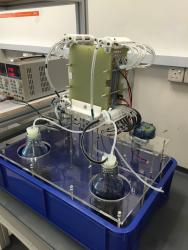Silica (SiO2) fibrous material is a special functional material with unique properties represented by amorphous fibre structure. These silica fibres can adsorb significantly more water than commercially available silica gel of the same mesoporous character. This feature is especially apparent in the range of medium relative humidity (30-70% RH), which is industrially the most important range for adsorption (in electronics, food, chemical industries, and numerous others). Owing to its porosity, the fibrous sorbent can be desorbed for its next use at significantly lower temperature (at least 20°C lower), which has a positive effect on the cost figure of the process. High specific surface area and mesoporosity are the main advantages, and make the material especially suitable for sorption and catalytic applications. The material can also be used as an adsorbent, catalytic carrier, battery electrolyte, etc.
With the wide deployment of renewable energy harvesting devices, such as solar cells and wind turbines, there is an urgency to develop high efficiency and economical energy storage systems to stabilize the intermittent and often unpredictable primary power sources before the power can be channelled to the grid safely or utilized for on-site loads. Redox flow batteries (RFBs) are regarded as promising electrochemical energy storage devices due to their special features of separable energy and power capacity. However, redox flow batteries tend to have lower energy densities than integrated cell architectures. Many approaches have been studied to improve the energy efficiency of RFBs. Among them, reducing shunt current loss and other parasitic loss is of great importance. This invention is capable of minimizing the shunt current in a redox flow battery through increasing the conductive path that exists between adjacent cells, without increasing maintenance cost or assembly complexity.



